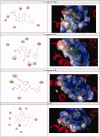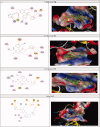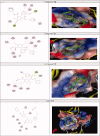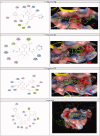Discovery of new symmetrical and asymmetrical nitrile-containing 1,4-dihydropyridine derivatives as dual kinases and P-glycoprotein inhibitors: synthesis, in vitro assays, and in silico studies
- PMID: 36093880
- PMCID: PMC9481151
- DOI: 10.1080/14756366.2022.2120478
Discovery of new symmetrical and asymmetrical nitrile-containing 1,4-dihydropyridine derivatives as dual kinases and P-glycoprotein inhibitors: synthesis, in vitro assays, and in silico studies
Abstract
Two new series of symmetric (1a-h) and asymmetric (2a-l) 1,4-DHP derivatives were designed, synthesised, and evaluated as anticancer agents. In vitro anticancer screening of target compounds via National cancer institute "NCI" revealed that analogues 1g, 2e, and 2l demonstrated antiproliferative action with mean growth inhibition percentage "GI%" = 41, 28, and 64, respectively. The reversal doxorubicin (DOX) effects of compounds 1g, 2e, and 2l were examined and illustrated better cytotoxic activity with IC50 =1.12, 3.64, and 3.57 µM, respectively. The most active anticancer analogues, 1g, 2e, and 2l, were inspected for their putative mechanism of action by estimating their epidermal growth factor receptor (EGFR), human epidermal growth factor receptor 2 (HER-2), and Bruton's tyrosine kinase (BTK) inhibitory activities. Furthermore, the antimicrobial activity of target compounds was assessed against six different pathogens, followed by determining the minimum inhibitory concentration "MIC" values for the most active analogues. Molecular docking study was achieved to understand mode of interactions between selected inhibitors and different biological targets.
Keywords: 1,4-DHPs; P-glycoprotein; anticancer; antimicrobial; apoptosis; multidrug resistance (MDR); receptor tyrosine kinases (RTKs).
Conflict of interest statement
No potential conflict of interest was reported by the authors.
Figures















Similar articles
-
Theoretical studies on 1,4-dihydropyridine derivatives as P-glycoprotein allosteric inhibitors: insights on symmetry and stereochemistry.J Biomol Struct Dyn. 2021 Aug;39(13):4752-4763. doi: 10.1080/07391102.2020.1780942. Epub 2020 Jun 23. J Biomol Struct Dyn. 2021. PMID: 32573349
-
In vitro cytotoxicity and docking study of novel symmetric and asymmetric dihydropyridines and pyridines as EGFR tyrosine kinase inhibitors.Chem Biol Drug Des. 2022 Jul;100(1):121-135. doi: 10.1111/cbdd.14058. Epub 2022 May 2. Chem Biol Drug Des. 2022. PMID: 35501997
-
Evaluation of anticancer effects of newly synthesized dihydropyridine derivatives in comparison to verapamil and doxorubicin on T47D parental and resistant cell lines in vitro.Cell Biol Toxicol. 2008 Apr;24(2):165-74. doi: 10.1007/s10565-007-9026-x. Epub 2007 Sep 6. Cell Biol Toxicol. 2008. PMID: 17805981
-
Novel benzothiazole-based dual VEGFR-2/EGFR inhibitors targeting breast and liver cancers: Synthesis, cytotoxic activity, QSAR and molecular docking studies.Bioorg Med Chem Lett. 2022 Feb 15;58:128529. doi: 10.1016/j.bmcl.2022.128529. Epub 2022 Jan 7. Bioorg Med Chem Lett. 2022. PMID: 35007724 Review.
-
Cancer cell permeability-glycoprotein as a target of MDR reverters: possible role of novel dihydropyridine derivatives.Curr Drug Targets. 2006 Aug;7(8):949-59. doi: 10.2174/138945006778019336. Curr Drug Targets. 2006. PMID: 16918323 Review.
Cited by
-
Antileishmanial and Antitoxoplasmal Activities of 1,4-Dihydropyridines.ACS Omega. 2025 Jul 10;10(28):31066-31076. doi: 10.1021/acsomega.5c04551. eCollection 2025 Jul 22. ACS Omega. 2025. PMID: 40727813 Free PMC article.
-
Novel N-Arylmethyl-aniline/chalcone hybrids as potential VEGFR inhibitors: synthesis, biological evaluations, and molecular dynamic simulations.J Enzyme Inhib Med Chem. 2023 Dec;38(1):2278022. doi: 10.1080/14756366.2023.2278022. Epub 2023 Nov 20. J Enzyme Inhib Med Chem. 2023. PMID: 37982203 Free PMC article.
-
Discovery of sulfonamide-tethered isatin derivatives as novel anticancer agents and VEGFR-2 inhibitors.J Enzyme Inhib Med Chem. 2023 Dec;38(1):2203389. doi: 10.1080/14756366.2023.2203389. J Enzyme Inhib Med Chem. 2023. PMID: 37122176 Free PMC article.
-
Discovery of new 1,3-diphenylurea appended aryl pyridine derivatives as apoptosis inducers through c-MET and VEGFR-2 inhibition: design, synthesis, in vivo and in silico studies.RSC Med Chem. 2024 Jun 12;15(7):2553-2569. doi: 10.1039/d4md00280f. eCollection 2024 Jul 17. RSC Med Chem. 2024. PMID: 39026631 Free PMC article.
-
Pyrrolizine/indolizine-bearing (un)substituted isoindole moiety: design, synthesis, antiproliferative and MDR reversal activities, and in silico studies.RSC Adv. 2023 Oct 20;13(44):30753-30770. doi: 10.1039/d3ra05310e. eCollection 2023 Oct 18. RSC Adv. 2023. PMID: 37869384 Free PMC article.
References
-
- Chen S, Zhao Y, Liu S, et al. . Epigenetic enzyme mutations as mediators of anti-cancer drug resistance. Drug Resistance Updates 2022;61:100821–13. - PubMed
-
- Li X, Li M, Huang M, et al. . The multi-molecular mechanisms of tumor-targeted drug resistance in precision medicine. Biomed Pharmacother 2022;150:113064–15. - PubMed
-
- Friedlaender A, Subbiah V, Russo A, et al. . EGFR and HER2 exon 20 insertions in solid tumours: from biology to treatment. Nat Rev Clin Oncol 2022;19:51–69. - PubMed
MeSH terms
Substances
LinkOut - more resources
Full Text Sources
Other Literature Sources
Research Materials
Miscellaneous
